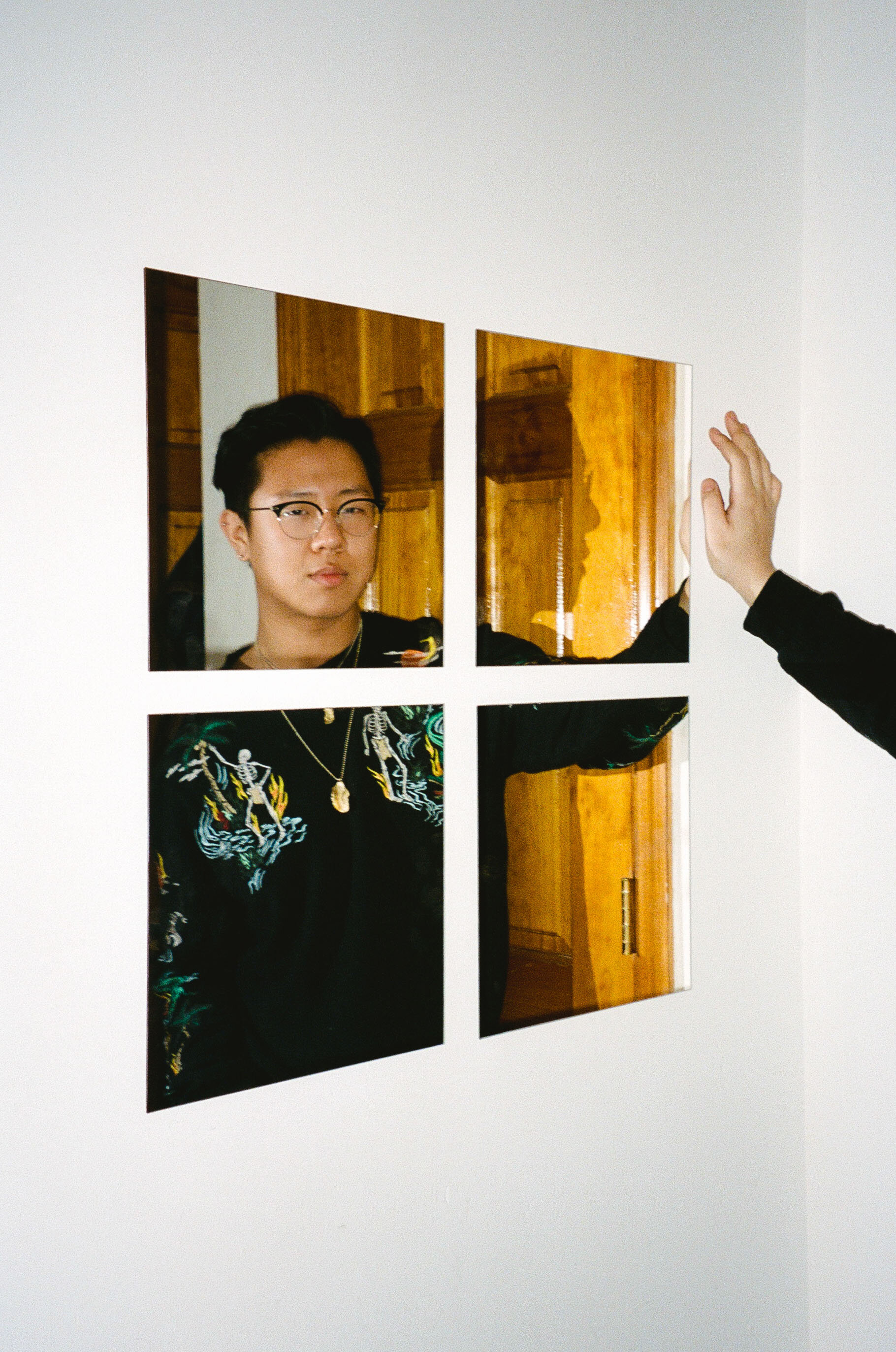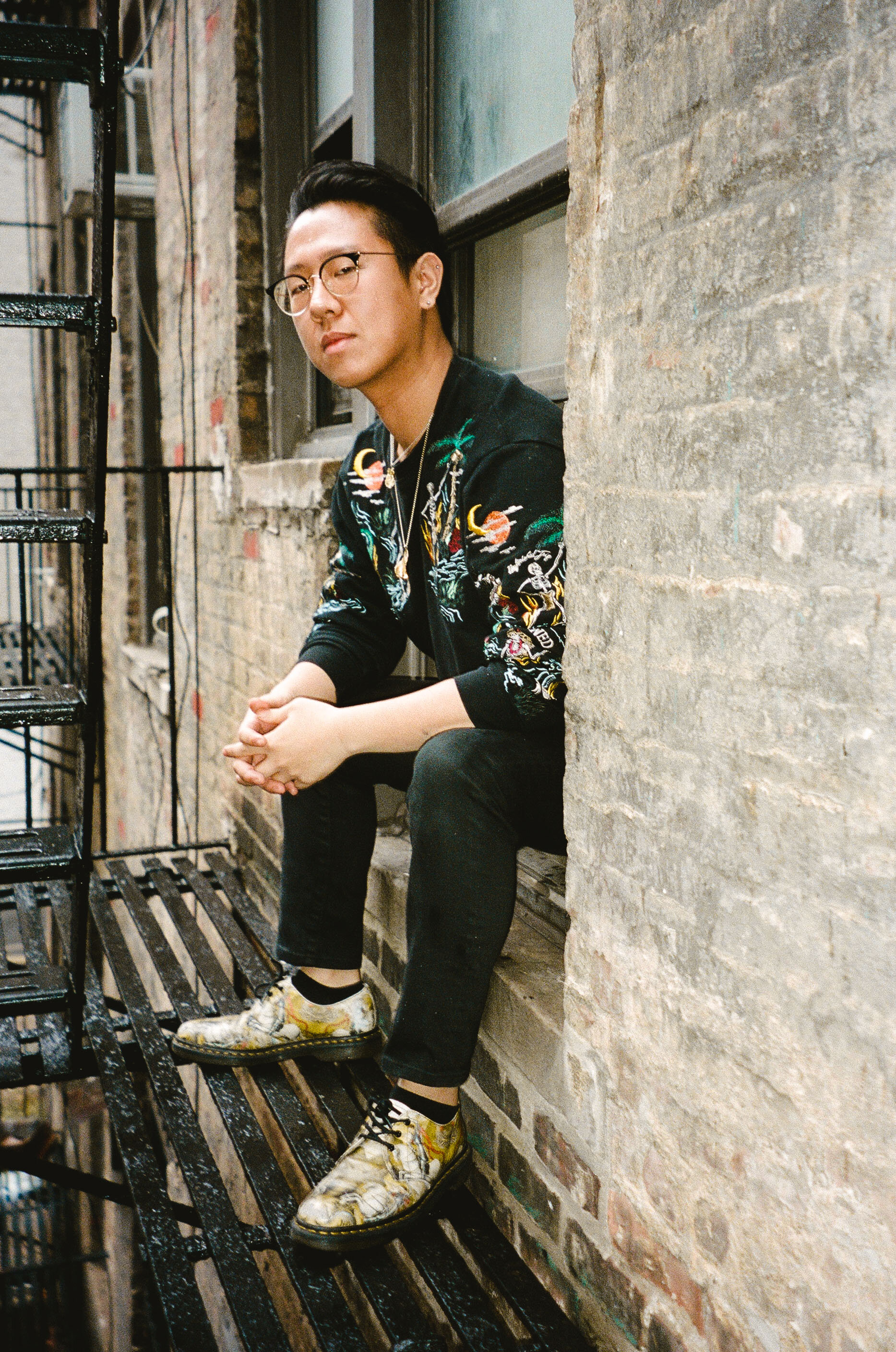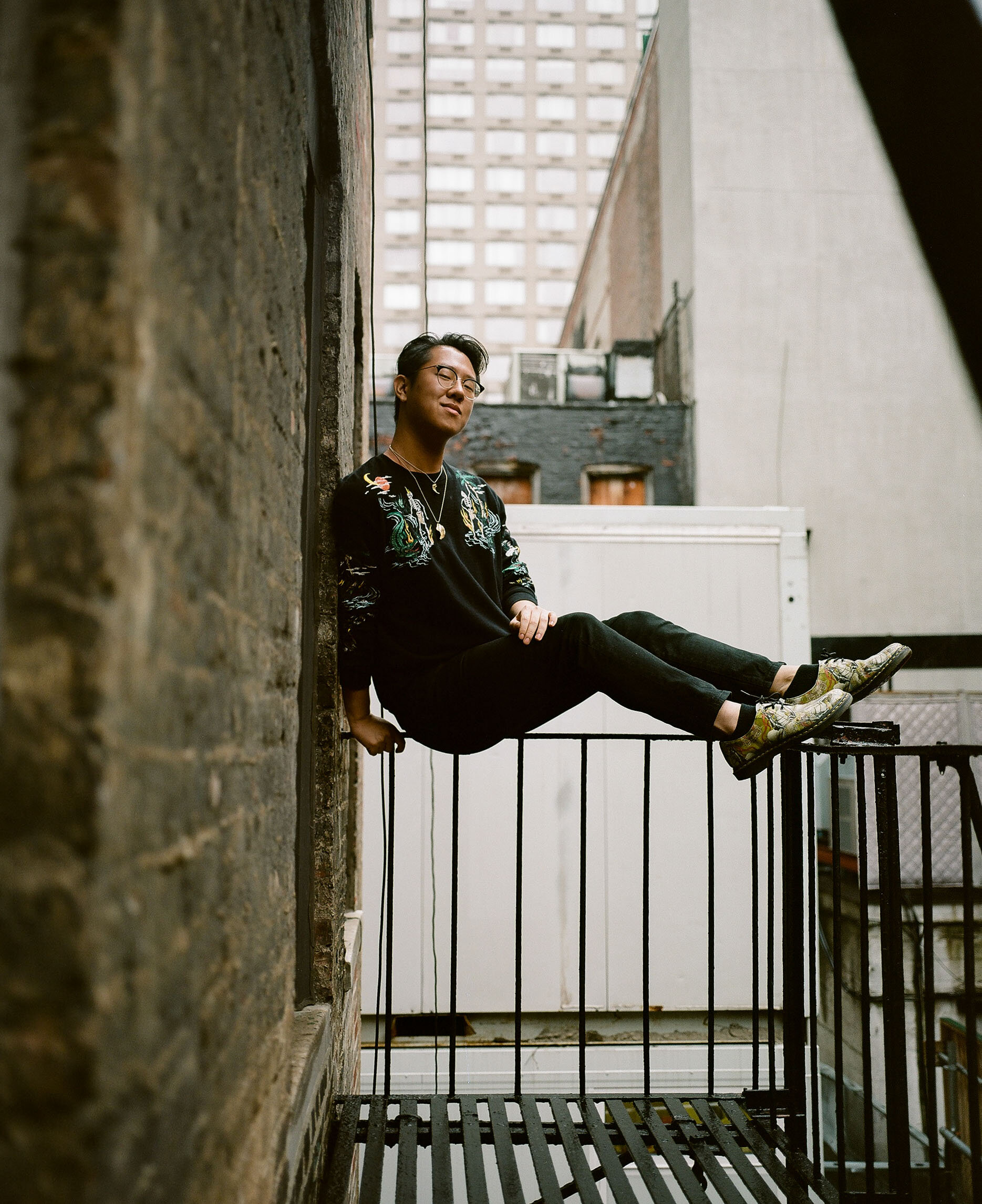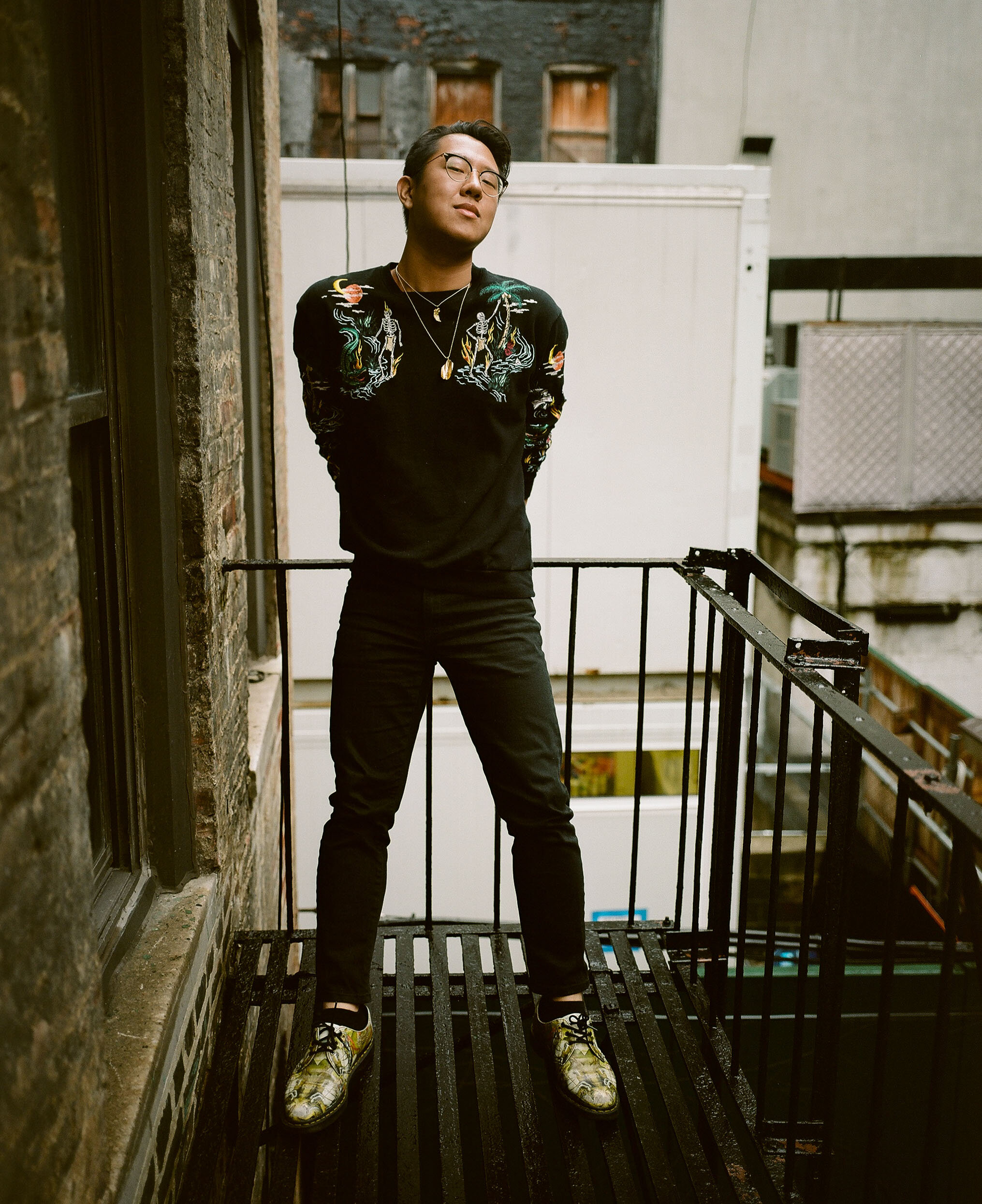




In conversation with Sophie Paquette
Photographs by Caitlyn Stachura
On your website, I noticed that you had your work divided into three primary groups. I was wondering if you could tell me a bit more about these disparate projects: how you group them, and where they diverge or overlap for you?
So, the three groups are Realitas, Phantasia, and Macabre. I’ll start with the first, Realitas. Those are simply my reality. They are mostly 35 mm film prints or photos, or candids I guess. I took Photo I almost four years ago, and that was the class that made me really want to be a visual arts major. Most of the things that I would shoot, before I had any concrete direction with film photography or studio photography and makeup, were candids, or I would say maybe commercial work—you know, photoshoots or Columbia runway shows. Most of the things that I would document were my life. When I was taking them, they were just like snapshots, you know, something for the Gram. I categorized them later.
In 2017, when I left school, and left all my friends and my life in New York, I had to go back to Korea, to the most toxic environment—the most machismo, culturally hierarchical, suppressive environment—one that I escaped and then was forced to go back to. I was looking back to a lot of my older works, and to my life in general. I have probably 70 rolls of film that I shot and a lot of them are shit, especially my first few months, completely exposed the wrong way—but the ones that I do have, and a lot of them, they’re just a great reminder of a life that’s not about death, and disease, sick people, stress, and cultural anxiety. I was working as a paramedic—EMT, very loosely—and in my district, unfortunately, we had a lot of suicides, a lot of sick people, and a lot of income inequality. You’d see some people with barely any housing, with alcoholism, and we’d have to transport them, or you’d see people with insane amounts of wealth who call 911 in Korea because they hurt their pinky. So I was just trying to get away from that by going through and documenting all of my old previous work and my life. That was my little escape, my little nostalgic moment that I documented on my website. That was Realitas.
Then Phantasia was actually the category that I made because I had already made the Macabre category, so the ones in Phantasia don’t really fit the same vibe. Under Phantasia, a lot of them are experiments as well, because I just recently got a home studio connected to my apartment back in Korea. I would get a backdrop, and I would get the soft boxes and cellophane and make colored lights, and I would do all of these works at like 2 am on a Friday, or on the weekends when I had the days off back home. Phantasia is more about me experimenting with makeup. Lavinia, Uranus… these were heavily inspired by this artist, @isshehungry on Instagram, who did Björk’s makeup for the recent tours with James T. Merry, creative director and headpiece designer. I was really obsessed with her new album and her shows—I mean, it’s Björk, come on, she’s amazing—recently with this new visual, virtual reality thing that she’s really pushing through, and this kind of environmentalism that she’s incorporating into her work, that really inspired me. It blew me away.
So I was researching, like, who is doing this insane makeup. And I found on Instagram @ishehungry, this German artist. I’m a firm believer that imitation is the highest form of flattery. To learn anything, you really have to. Trying to be original off the bat is so difficult. If it’s not something you’re proudly releasing to the world as your own, I feel like it’s okay to copy, and to try to do it. I adapted some of my looks from Hungry’s looks, and I really experimented with that. I realized I was more extra terrestrial, kind of out there, on a lighter note. Phantasia’s mostly about that: experimenting with colors and lights, and just having fun.
Macabre: they’re the things that are slightly more unsettling, discomforting, almost even grotesque. In my new work, too, the barrier between reality and unreality is lessened. I’ve always been interested in the horror genre, horror films, especially the 70’s Italian Giallo films, like Suspiria and Dario Argento’s other films. Those very campy, slightly creepy things I’ve always been obsessed with. So Macabre, I wanted something that’s not too campy, something that’s not too overt or direct. I didn’t want to be too obvious. One of the series, the ones in German, these are the ones that came almost out of a mental breakdown. Most of the work, especially in the Macabre series, are not from a great time in my life—I was missing Columbia, missing my friends. I was more upset by the fact that when I would come back after my service all of my friends would have graduated because I left sophomore year and it’s a 2-year service.
I got this lace front wig online. I played with it for a long time—it was blonde, it was Cali, valley girl blonde, it basically became so fried that I couldn’t really make it look good on its own. Because it was a cheap lace front, right, synthetic, not like human hair. I was thinking, “How can I dye it to a darker color and stick it so it doesn’t wash away immediately?” I used sumi ink and poured it in a basin, dunked the wig overnight, let it dry, did shampoo and conditioner, and it turned out this beautiful, ashy gray color. That basically set the tone for my project. I went down to my studio, sewed in some black extensions as well to give it some length, some volume, a little wild something.
So I had that wig on. I basically just got my dirty brushes, I don’t think I even used any actual products, I just rubbed dirty brushes all over my face and eyes. I got that dirty, grungy, lived-in, almost a mask-like look. I had taken like 700 photos for 4 photos that I uploaded. But that was basically the way I could deal with the life I was living, doing something so creative, and engaging with and exploring my creative side. I was very suppressed when I was working in the emergency medical field. I didn’t want to let go of the momentum I had when I was in my sophomore year, when I picked up photography and did a lot of my makeup work, like individual studio sessions and photoshoots with Columbia students as models, and Kevin Chiu, the infamous Kevin Chiu, the amazing Kevin Chiu, class of 2017, who would take the photographs, and my best friend, Kosta Karakashyan, class of 2019, he was a stylist. Us three, we’d book the Wallach lounge from like 7 am to noon and have students as models, and we would make beautiful photos, and I would experiment and really practice mastering my makeup skills.
The Macabre, it is my favorite category of the three—well, I’d be lying if I said it all came from a dark, depressing place. A lot of these works are just exploring my old love for the horror genre, you know, the monsters, the creature features, the supernatural kind of shit. One of my favorites, Markos, was from before I had a proper DSLR, I only had my iPhone 7 in Portrait Mode. I had a studio setup, but I was mostly doing iPhone photography, and film occasionally. This one was when I got some black body paint and some acrylic sticker nails, you know, the ones they sell in Duane Reade, and I stacked them—three, because I couldn’t find the super long ones—and it kind of looks like an insect, more offsetting. I had two sets of contact lenses on one eye to intensify the color, so I got that milky but also really intense light look, because I have really dark eyes. This red, magenta, blue lighting, it’s directly stolen from the original Suspiria film by Dario Argento.
I was definitely curious about the process of photographing these pieces. To me, I imagined it must be kind of like documenting a sculpture--trying to find an angle that successfully flattens this dynamic piece into this more stagnant, permanent form; also maintaining that plasticity while creating this new product, the photo, which exists as its own piece separate from the body in life.
I say that I’m a photographer as well, but really I just stick to my guns. If I’m doing photographic work or shooting for my own purposes, I usually stick to 35 mm film, 50 mm lens, and my Nikon FE camera. The camera that I used for these is actually my sister’s. My sister lent me her camera for the photoshoots in my studio back home. I had no idea. I’m a luddite at heart, I’m so overwhelmed by all these buttons and options and settings. Luckily, I was able to get to know the basics—how to turn it on, how to use a remote control, and to play with the settings until I find something that works. Then I got an Adobe Cloud subscription for Lightroom and Photoshop. Photographing has always been a struggle, especially with digitals. I would take like 800 or 900 photos of one look, and it would take hours and hours. For each frame I would take the shot, scurry back to the camera, look, and then reference it—you know, I’m a little bit too close to the edge of the frame, or I should turn, orm that’s not a flattering angle. Also, I’m blind without my glasses, and in none of the work am I wearing glasses.
I actually think of it as kind of taking a photograph of a sculpture. The actual work is a sculpture itself but you’re just seeing a representation, a portrayal. But with sculpture you can have it moved, taken around, exhibited. Makeup is such a temporal medium. If I take it off, or if it smudges a little, it’s completely different. So the photograph automatically has such a huge importance to me. They have to be right. The photographs, the makeup, the styling, they all have equal importance to me because if one fails, then all of it crumbles.
Could you talk a bit more about stylistic decisions you make when photographing, such as the extra-media elements added that might not be in the body’s immediate space—for example, the smoke shrouding the figure in “Typhoon Soulik,” or the yarn in “Lavinia”?
“Lavinia” is based on the Shakespeare play “Titus Andronicus”, which was a book I read at Columbia. I took a course called “Tragic Bodies,” it was a Barnard course, my first ever college class, and it was amazing. We were talking about the physical body, and the demise of the body, the hero’s demise in terms of the physical body, and other bodies—queer bodies, trans bodies, sick bodies. With that foundation, and working in a field where you are hands on with the physical body, I feel like it was just a natural progression that I would have an obsession with the physical form. “Lavinia” was during my peak experimental phase, with makeup and everything. I got those really black contact lenses, I was really feeling myself. I was still very inspired by Hungry’s Björk look and her personal work as well, but I wanted to do something a bit different, and I wanted to utilize some props I had lying around my house.
So the yarn, they are tiny little ropes. I had them lying around for about a month, and I was in my studio and I wanted to do something, so I decided I was gonna cut these up and glue them on my mouth. It was some strong glue that took me hours to delicately rip out. I would get pleasantly drunk in my studio, because it’s my studio, and I could just do whatever I want. So that look actually came from that specific prop. Because often, you know a certain makeup inspires the look, or a certain eye look, or a mouth, a wig, something. A lot of my works come from a beginning point. So I looked at it, I decided I wanted it on my mouth: it kinda looks like blood, and in a theater, in a play, when you can’t have spraying blood they use red fabric or yarn to flow around, so it’s like a fluid, red motion. The eye look was completely separate. I had the wig on. And it was just the shirt that I was wearing, but that whole mouth piece really solidified my intention. I immediately thought of Lavinia, who is the daughter of the general Titus—she was assaulted and dismembered by the two sons of Titus’ enemy.
With “Typhoon Soulik,” that one’s a little on the nose because around two years ago, East Asia had a really bad typhoon. This was shot the night before it was supposed to hit Korea. It was rainy, it was a very depressing day. I wanted something to fit the general mood of the entire East Asian side of the continent. I’m obsessed with storms, there’s something so primordial and raw about them, a break from manmade society. So I went down to my studio on that rainy night, probably 1 am, put some blue cellophane on my studio lights, and created this bluey, emerald eye. Just playing around, using the stuff I had out from my kit. Then I decided to get a spray bottle and wet myself, you know, because it’s the storm. I underestimated how much water I needed, so I ended up basically pouring the whole thing on my head. And this is just me being playful, experimenting, but I wanted something a little more misty, something of the elements. I was like, that’s basically vape! So I just *mimes vaping* and clicked. That took, like, I don’t know how many shots to get one good photo. But it’s also me trying to go along with the mood, to be inspired and go with the flow. But yeah, having fun. That’s my motto. Living life through the prism of pleasure.
With the idea of fun, I noticed you had a statement on your website about taking the work at “face value,” and you talked about working mostly with people you know, people you’re close to. I guess this applies to working with yourself too, but do you think that there’s something that layer of intimacy and familiarity adds to your work and the process?
Yeah, like I said, all of the things I do are personal. That’s why I don’t really like street photography or taking random photos of people. Because, a) I have really bad social anxiety in uncomfortable or awkward situations, like sometimes I can’t even order my own shit from McDonald’s, I have to have a friend do it for me because it’s so bad. People think otherwise, because I’m loud and boisterous, but outside in the streets, I can’t fucking do that. Also, unless I get their permission and consent to photograph them, when you’re on the go you have to ask permission later. But I can’t do that, because ethically it’s just kind of off. You end up with a very uncomfortable situation, so I don’t like that. All of the models and the subjects are all my friends. It’s also an event, it’s not just the art form or the practice itself. You know, I’m hanging out with my friends, and I want to document this great time. It doesn’t have to be amazing magazine-style portraits or spreads, it can just be them, you know, squinting their eyes at the camera, or hugging each other.
It doesn’t have to be so serious all the time. It helps if you’re familiar and have an intimate relationship with the subjects, that’s when that kind of true happiness emerges. That’s why I say always take it at face value, don’t think too deep. That’s my thing with art: just fucking enjoy it. Look at it, and if it sparks joy, then it sparks joy, if it doesn’t, just move on. Especially because I’m now taking a lot more art classes, things get highly academic when you’re talking about art. The context—the social, cultural, political context—behind your art can become so convoluted and complex that it becomes inaccessible, I think.
So, you mentioned this a little bit, but I wanted to ask about your upcoming project. Specifically, you said it was based on both Suspiria movies, and then the original prose piece they are based on. I was wondering for you as an artist, what that process of translation is like? So, getting something that was once text, and then lived through bodies in one film, and then another film, and where do you plan to go with that? Where do you see yourself in this lineage of translation, and how does that inform your work?
The thing with Suspiria is that it’s an unhealthy obsession. I was a huge fan of the 1977 film because it’s a cult classic, any horror buff will be like, “Oh yeah, Suspiria, classic!” But as a horror film, it’s not that “horror,” it’s very campy. The visuals are stunning, and that’s where they take the gold prize. But it was always kind of lacking in the story telling and plot to me. I was always curious, why call it Suspiria, because they never mention the word suspiria—it’s a movie about witches but what the hell does that mean? Later I found out there’s a source material, it’s actually not about witches and the director adapted that material into this universe of witches. But that was never really expanded in his later work. And then in 2018 or something, I learned that Luca Guadagnino, one of my favorite directors, was directing the remake. I kid you not, I almost shit my pants. Two of my babies, Suspiria and Luca Guadagnino, were being involved. And then I realized Tilda Swinton is in it, who’s like my mother. She’s an artist I love, and adore, and admire.
I saw the trailer when it came out and my mind was fucking blown, because it’s so different from the original. When I watched the new one, I was obsessed. The remake is about a coven of witches in a dance company, it’s modern dance, and it’s choreographed by Damien Jalet, who’s an amazing choreographer that I’ve been obsessed with lately as well. So much intention is in the body, and the spells, and the structural hierarchy of the witches, which I could relate to, having worked in that kind of Korean environment. So that seed was planted in my head the moment I knew about the first film, and I did a lot more research about the original source material, the original storyline.
So, I read the source material, and I didn’t realize how rich it was. Thomas de Quincey writes about how, as there are three muses, three inspirations, there are three ladies of sorrow. So there are three mothers, Mother Suspiriorum, Mother Tenebraum, and Mother Lachrymarum, mother of size, darkness, and tears. The prose goes on to explain in detail about each of these mother figures—their domain, what kind of sorrow they bring, what kind of chaos and havoc they bring as well. That fit so much with my vibe, my direction, I could really explore the depths of sorrow. When I started to work on this project, it was an insanely emotional, chaotic, stressful time. I needed this. Because the cinematic universe of Suspiria had such an important place in my heart, I didn’t want to half ass this. That’s why it’s still an ongoing project, I’m constantly introducing—not just with makeup and photography, but now with modern dance inspired by the choreography in the remake.
































